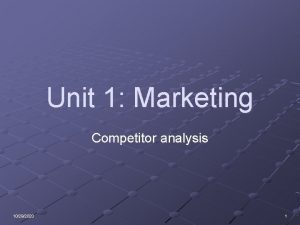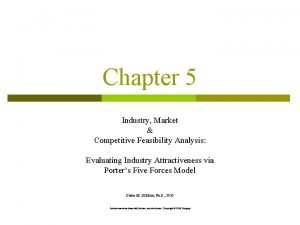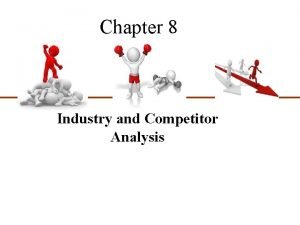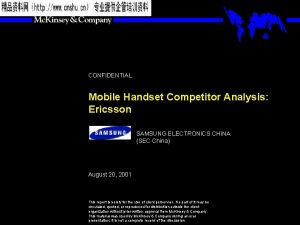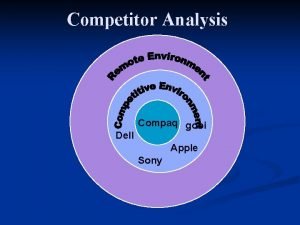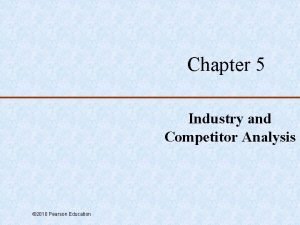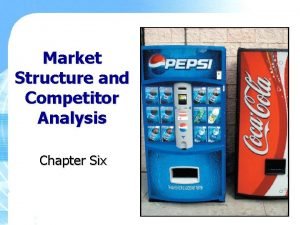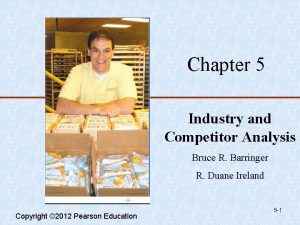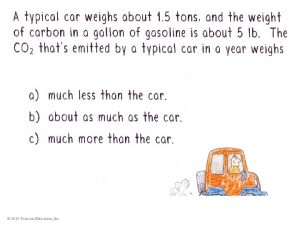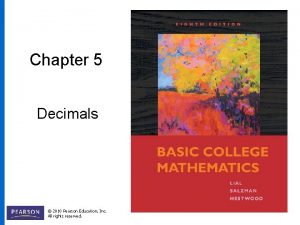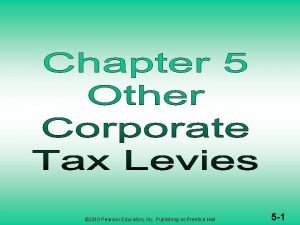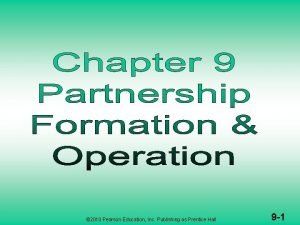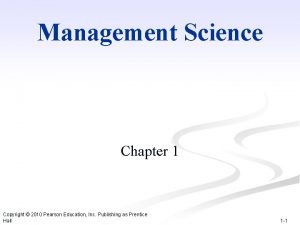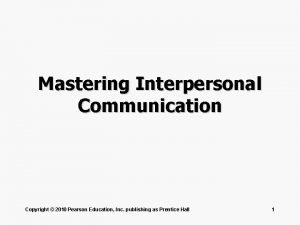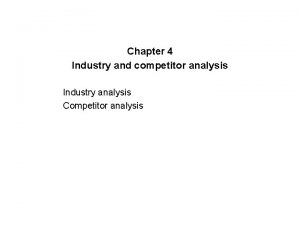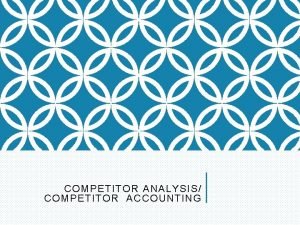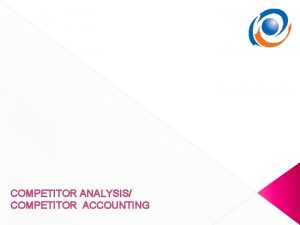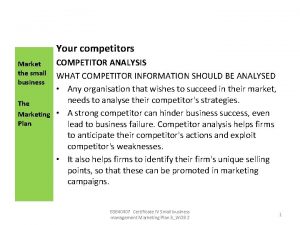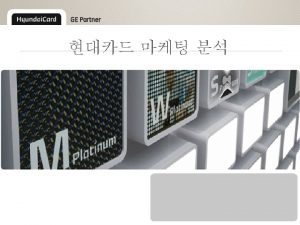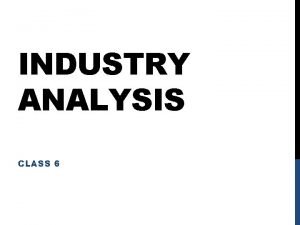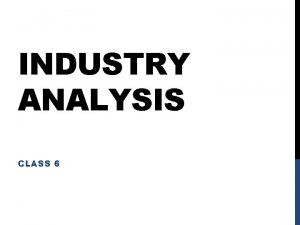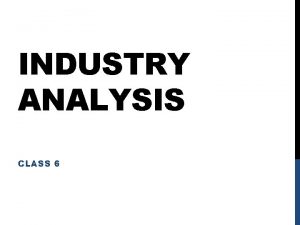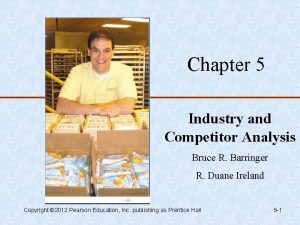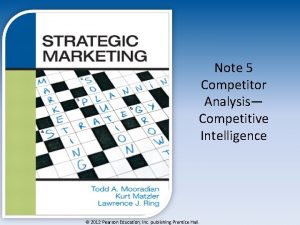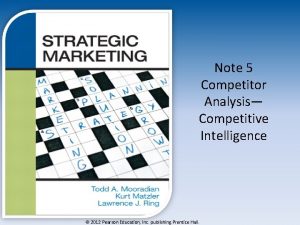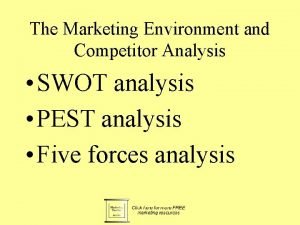Chapter 5 Industry and Competitor Analysis 2010 Pearson









































- Slides: 41

Chapter 5 Industry and Competitor Analysis © 2010 Pearson Education

Chapter Objectives 1. Explain the purpose of an industry analysis. 2. Identify the five competitive forces that determine industry profitability. 3. Explain the role of “barriers to entry” in creating disincentives for firms to enter an industry. 4. List the four industry-related questions to ask before pursuing the idea for a firm. 5. The Five Forces Model © 2010 Pearson Education

Chapter Objectives 6. Identify the five primary industry types and the opportunities they offer. 7. Explain the purpose of a competitor analysis. 8. Describe the reasons for completing a competitive analysis grid. © 2010 Pearson Education

What is Industry Analysis? • Industry – An industry is a group of firms producing a similar product or service, such as music, pilates and yoga studios, and solar panel manufacturing. • Industry Analysis – Is business research that focuses on the potential of an industry. • Competitor analysis – is a detailed evaluation of a firm’s competitors. Once a firm decides to enter an industry and chooses a market in which to compete, it must gain an understanding of its competitive environment. © 2010 Pearson Education

What is Industry Analysis Importance? Importance Industry Analysis © 2010 Pearson Education • Once it is determined that a new venture is feasible in regard to the industry and market in which it will compete, a more in-depth analysis is needed to learn the ins and outs of the industry. • The analysis helps a firm determine if the niche market it identified during feasibility analysis is favorable for a new firm.

Three Key Questions When studying an industry, an entrepreneur must answer three questions before pursuing the idea of starting a firm. Question 1 Question 2 Question 3 Is the industry accessible—in other words, is it is realistic place for a new venture to enter? Does the industry contain markets that are ripe for innovation or are underserved? Are there positions in the industry that avoid some of the negative attributes of the industry as a whole? © 2010 Pearson Education

How Industry and Firm-Level Factors Affect Performance • Firm Level Factors – Include a firm’s assets, products, culture, teamwork among its employees, reputation, and other resources. • Industry Level Factors – Include threat of new entrants, rivalry among existing firms, bargaining power of buyers, and related factors. • Conclusion – In various studies, researchers have found that from 8% to 30% of the variation in firm profitability is directly attributable to the industry in which a firm competes. © 2010 Pearson Education

Techniques Available to Assess Industry Attractiveness Assessing Industry Attractiveness Study Environmental and Business Trends © 2010 Pearson Education The Five Competitive Forces Model

Studying Industry Trends • Environmental Trends – Include economic trends, social trends, technological advances, and political and regulatory changes. – For example, industries that sell products to seniors are benefiting by the aging of the population. • Business Trends – Other trends that impact an industry. – For example, are profit margins in the industry increasing or falling? Is innovation accelerating or waning? Are input costs going up or down? © 2010 Pearson Education

The Five Forces Model • Explanation of the Five Forces Model – The five competitive forces model is a framework entrepreneurs use to understand an industry’s structure. – The model is composed of the forces that determine industry profitability. – They help determine the average rate of return for the firms in an industry. © 2010 Pearson Education

The Five Competitive Forces Model • Explanation of the Five Forces Model (continued) – Each of the five-forces impacts the average rate of return for the firms in an industry by applying pressure on industry profitability. – Well managed firms try to position their firms in a way that avoids or diminishes these forces—in an attempt to beat the average rate of return of the industry. © 2010 Pearson Education

The Five Competitive Forces Model © 2010 Pearson Education

Threat of Substitutes • Threat of Substitutes – The price that consumers are willing to pay for a product depends in part on the availability of substitute products. – For example, there are few if any substitutes for prescription medicines, which is one of the reasons the pharmaceutical industry is so profitable. – In contrast, when close substitutes for a product exist, industry profitability is suppressed, because consumers will opt out if the price gets too high. © 2010 Pearson Education

Threat of Substitutes • Threat of Substitutes (continued) – The extent to which substitutes suppress the profitability of an industry depends on the substitute between alternatives. – This is why firms in an industry often offer their customers amenities to reduce the likelihood that they will switch to a substitute product, even in light of a price increase. © 2010 Pearson Education

Threat of Substitutes • A customer could easily get a cup of coffee cheaper at one of Starbuck’s competitors. • To decrease the likelihood of this, Starbucks offers highquality fresh coffee, good service, and a pleasant atmosphere. • Starbucks has therefore reduced the threat of substitutes. © 2010 Pearson Education

Threat of New Entrants • Threat of New Entrants – If the firms in an industry are highly profitable, the industry becomes a magnet to new entrants. – Unless something is done to stop this, the competition in the industry will increase, and average industry profitability will decline. – Firms in an industry to keep the number of new entrants low by erecting barriers to entry. • A barrier to entry is a condition that creates a disincentive for a new firm to enter an industry. © 2010 Pearson Education

Threat of New Entrants Barriers to Entry Barrier to Entry Economies of Scale Explanation Industries that are characterized by large economies of scale are difficult for new firms to enter, unless they are willing to accept a cost disadvantage. Product differentiation Industries such as the soft drink industry that are characterized by firms with strong brands are difficult to break into without spending heavily on advertising. Capital requirements The need to invest large amounts of money to gain entrance to an industry is another barrier to entry. © 2010 Pearson Education

Threat of New Entrants Barriers to Entry (continued) Barrier to Entry Explanation Cost advantages independent of size Existing firm may have cost advantages not related to size. For example, the existing firms in an industry may have purchased land when it was less expensive than it is today. Access to distribution channels Distribution channels are often hard to crack. This is particularly true in crowded markets, such as the convenience store market. Government and legal barriers © 2010 Pearson Education Some industries, such as broadcasting, require the granting of a license by a public authority to compete.

Rivalry Among Existing Firms (17 -10 A) 1 of 3 • Rivalry Among Existing Firms – In most industries, the major determinant of industry profitability is the level of competition among existing firms. – Some industries are fiercely competitive, to the point where prices are pushed below the level of costs, and industrywide losses occur. – In other industries, competition is much less intense and price competition is subdued. © 2010 Pearson Education

Rivalry Among Existing Firms 2 of 3 Factors that determine the intensity of the rivalry among existing firms in an industry. Number and balance of competitors Degree of difference between products © 2010 Pearson Education The more competitors there are, the more likely it is that one or more will try to gain customers by cutting its price. The degree to which products differ from one product to another affects industry rivalry.

Rivalry Among Existing Firms Factors that determine the intensity of the rivalry among existing firms in an industry (continued) Growth rate of an industry Level of fixed costs © 2010 Pearson Education The competition among firms in a slow-growth industry is stronger than among those in fastgrowth industries. Firms that have high fixed costs must sell a higher volume of their product to reach the break-even point than firms with low fixed costs.

Bargaining Power of Suppliers • Bargaining Power of Suppliers – Suppliers can suppress the profitability of the industries to which they sell by raising prices or reducing the quality of the components they provide. – If a supplier reduces the quality of the components it supplies, the quality of the finished product will suffer, and the manufacturer will eventually have to lower its price. – If the suppliers are powerful relative to the firms in the industry to which they sell, industry profitability can suffer. © 2010 Pearson Education

Bargaining Power of Suppliers Factors that have an impact on the ability of suppliers to exert pressure on buyers Supplier concentration When they are only a few suppliers that supply a critical product to a large number of buyers, the supplier has an advantage. Switching costs are the fixed costs that buyers encounter when switching or changing from one supplier to another. If switching costs are high, a buyer will be less likely to switch suppliers. © 2010 Pearson Education

Bargaining Power of Suppliers Factors that have an impact on the ability of suppliers to exert pressure on buyers (continued) Attractiveness of substitutes Threat of forward integration © 2010 Pearson Education Supplier power is enhanced if there are no attractive substitutes for the product or services the supplier offers. The power of a supplier is enhanced if there is a credible possibility that the supplier might enter the buyer’s industry.

Bargaining Power of Buyers • Bargaining Power of Buyers – Buyers can suppress the profitability of the industries from which they purchase by demanding price concessions or increases in quality. – For example, the automobile industry is dominated by a handful of large companies that buy products from thousands of suppliers in different industries. This allows the automakers to suppress the profitability of the industries from which they buy by demanding price reductions. © 2010 Pearson Education

Bargaining Power of Buyers Factors that have an impact on the ability of suppliers to exert pressure on buyers Buyer group concentration If there are only a few large buyers, and they buy from a large number of suppliers, they can pressure the suppliers to lower costs and thus affect the profitability of the industries from which they buy. Buyer’s costs The greater the importance of an item is to a buyer, the more sensitive the buyer will be to the price it pays. © 2010 Pearson Education

Bargaining Power of Buyers Factors that have an impact on the ability of buyers to exert pressure on suppliers (continued) Degree of standardization of supplier’s products The degree to which a supplier’s product differs from its competitors affect the buyer’s bargaining power. Threat of backward integration The power of buyers is enhanced if there is a credible threat the buyer might enter the supplier’s industry. © 2010 Pearson Education

First Application of the Five Forces Model • First Application of the Model – The five forces model can be used to assess the attractiveness of an industry by determining the level of threat to industry profitability for each of the forces. – If a firm fills out the form shown on the next slide and several of the threats to industry profitability are high, the firm may want to reconsider entering the industry or think carefully about the position it would occupy. © 2010 Pearson Education

First Application of the Five Forced Model Assessing Industry Attractiveness Using the Five Forces Model © 2010 Pearson Education

Second Application of the Five Forces Model • Second Application of the Model – The second way a new firm can apply the five forces model to help determine whether it should enter an industry is by using the model to answer several key questions. – The questions are shown in the figure on the next slide, and help a firm project the potential success of a new venture in a particular industry. © 2010 Pearson Education

Second Application of the Five Forced Model Using the Five Forces Model to Pose Questions to Determine the Potential Success of a New Venture in an Industry © 2010 Pearson Education

Industry Types and the Opportunities They Offer • Emerging Industries – Industries in which standard operating procedures have yet to be developed. • Opportunity: First-mover advantage. • Fragmented Industries – Industries that are characterized by a large number of firms of approximately equal size. • Opportunity: Consolidation. © 2010 Pearson Education

Industry Types and the Opportunities They Offer • Mature Industries – Industries that are experiencing slow or no increase in demand. • Opportunities: Process innovation and after-sale service innovation. • Declining Industries – Industries that are experiencing a reduction in demand. • Opportunities: Leadership, establishing a niche market, and pursuing a cost reduction strategy. © 2010 Pearson Education

Industry Types and the Opportunities They Offer • Global Industries – Industries that are experiencing significant international sales. • Opportunities: Multidomestic and global strategies. © 2010 Pearson Education

Competitor Analysis • What is a Competitor Analysis? – A competitor analysis is a detailed analysis of a firm’s competition. – It helps a firm understand the positions of its major competitors and the opportunities that are available. – A competitive analysis grid is a tool for organizing the information a firm collects about its competitors. © 2010 Pearson Education

Identifying Competitors Types of Competitors New Ventures Face © 2010 Pearson Education

Sources of Competitive Intelligence • Collecting Competitive Intelligence – To complete a competitive analysis grid, a firm must first understand the strategies and behaviors of its competitors. – The information that is gathered by a firm to learn about its competitors is referred to as competitive intelligence. – A new venture should take care that it collects competitive intelligence in a professional and ethical manner. © 2010 Pearson Education

Sources of Competitive Intelligence Ethical ways to obtain information about competitors • Attend conferences and trade shows. • Purchase competitor’s products. • Study competitors’ Web sites. • Set up Google and Yahoo! e-mail alerts. • Read industry-related books, magazines, and Web sites. • Talk to customers about what motivated them to buy your product as opposed to your competitor’s product. © 2010 Pearson Education

Sources of Competitive Intelligence • Many companies attend trade shows to not only display their products, but to see what their competitors are up to. • This is a photo of the 2008 Consumer Electronics Trade Show in Las Vegas. © 2010 Pearson Education

Completing a Competitive Analysis Grid • Competitive Analysis Grid – A tool for organizing the information a firm collects about its competitors – A competitive analysis grid can help a firm see how it stakes up against its competitors, provide ideas for markets to pursue, and identify its primary sources of competitive advantage. © 2010 Pearson Education

Competitive a Analysis Grid for Expresso Fitness © 2010 Pearson Education
 Industry and competitor analysis
Industry and competitor analysis Lehmann and winer competitor analysis
Lehmann and winer competitor analysis Competition analysis in feasibility study
Competition analysis in feasibility study Myk pono competitor analysis
Myk pono competitor analysis Objective of industry analysis
Objective of industry analysis Nokia competitor analysis
Nokia competitor analysis Ericsson axd 320
Ericsson axd 320 Apple competitor analysis
Apple competitor analysis Competitive analysis grid
Competitive analysis grid Competitor analysis theory
Competitor analysis theory Competitor analysis grid
Competitor analysis grid 2010 pearson education inc
2010 pearson education inc 2010 pearson education inc
2010 pearson education inc 2010 pearson education inc answers
2010 pearson education inc answers 2010 pearson education inc answers
2010 pearson education inc answers 2010 pearson education inc answers
2010 pearson education inc answers 2010 pearson education inc answers
2010 pearson education inc answers 2010 pearson education inc
2010 pearson education inc 2010 pearson education inc
2010 pearson education inc Copyright 2010 pearson education inc
Copyright 2010 pearson education inc 2010 pearson education inc
2010 pearson education inc Copyright 2010 pearson education inc
Copyright 2010 pearson education inc 2010 pearson education inc answers
2010 pearson education inc answers Decimal in words example
Decimal in words example 2010 pearson education inc
2010 pearson education inc 2010 pearson education inc
2010 pearson education inc 2010 pearson education inc
2010 pearson education inc Pearson 2010
Pearson 2010 Two coins rotate on a turntable
Two coins rotate on a turntable 2010 pearson education inc
2010 pearson education inc 2010 pearson education inc
2010 pearson education inc 2010 pearson education inc answers
2010 pearson education inc answers 2010 pearson education inc
2010 pearson education inc 2010 pearson education inc
2010 pearson education inc Copyright 2010 pearson education inc
Copyright 2010 pearson education inc Copyright 2010 pearson education inc
Copyright 2010 pearson education inc Copyright 2010 pearson education inc
Copyright 2010 pearson education inc Copyright 2010 pearson education inc
Copyright 2010 pearson education inc Copyright 2010 pearson education inc
Copyright 2010 pearson education inc Copyright 2010 pearson education inc
Copyright 2010 pearson education inc Copyright 2010 pearson education inc
Copyright 2010 pearson education inc 2010 pearson education inc
2010 pearson education inc

